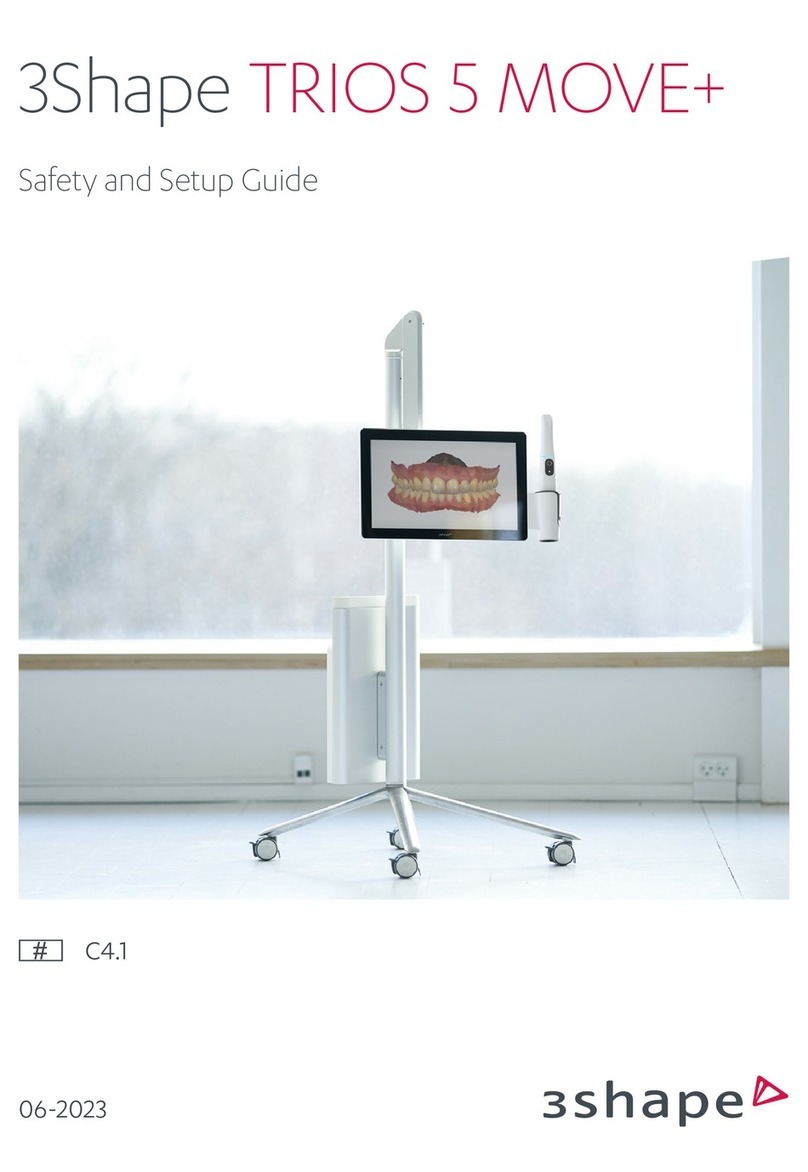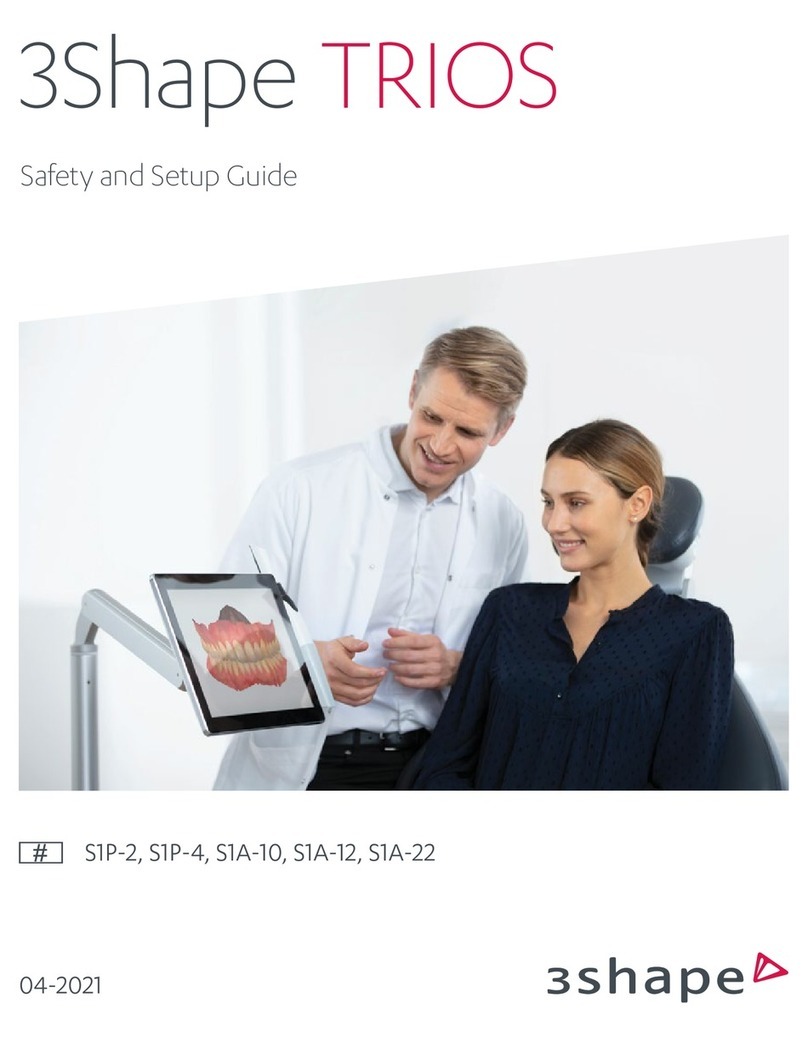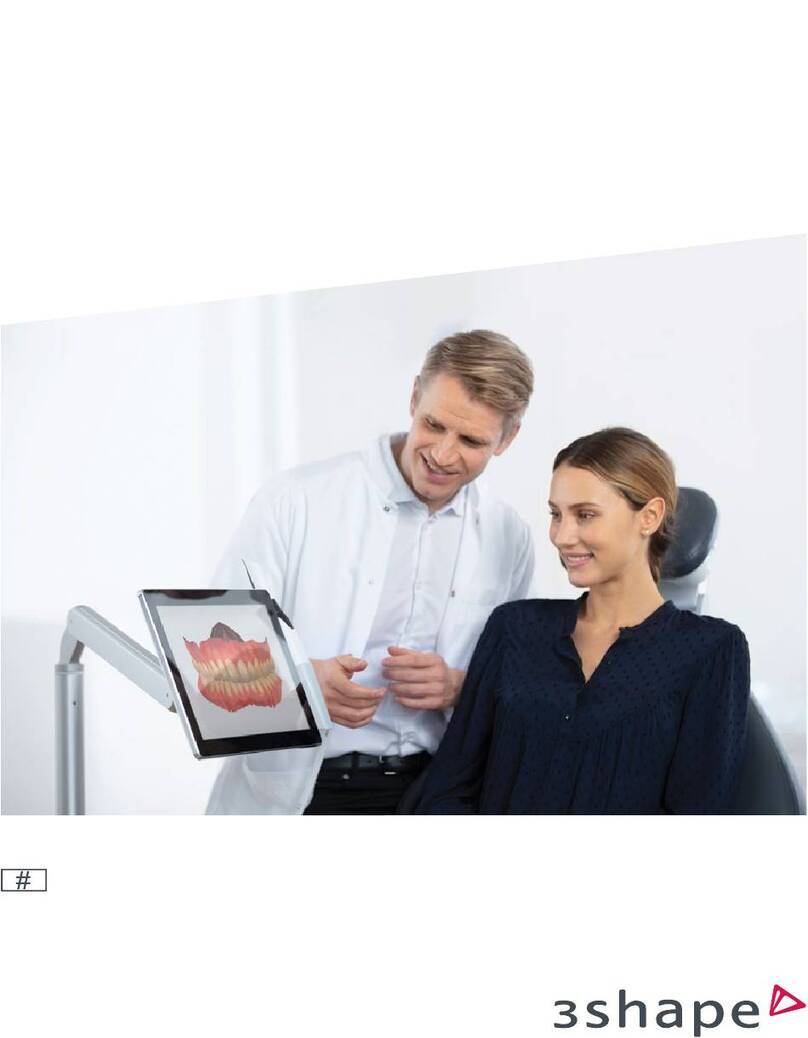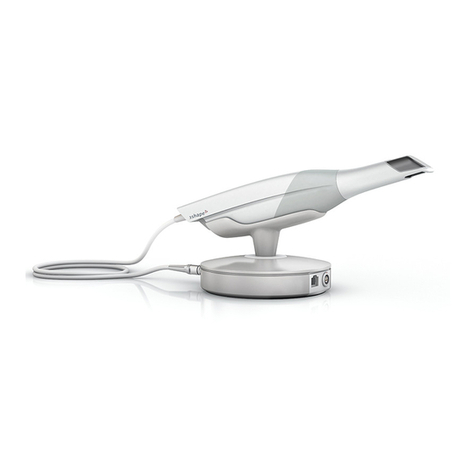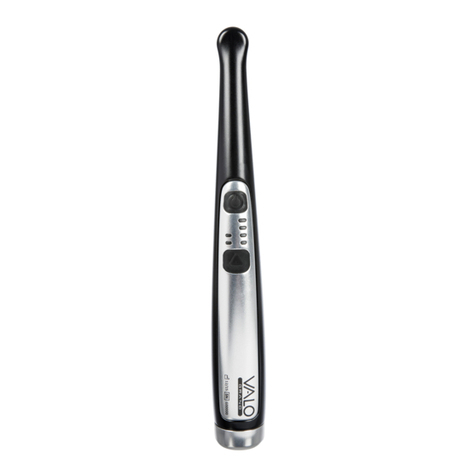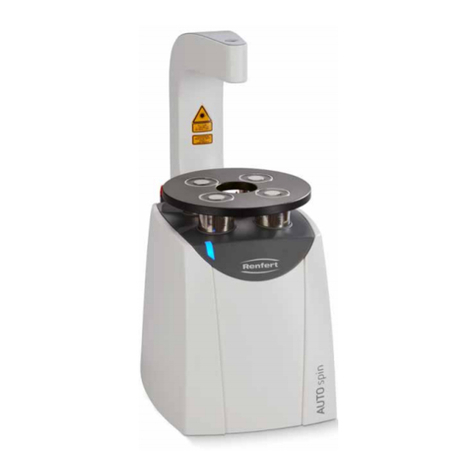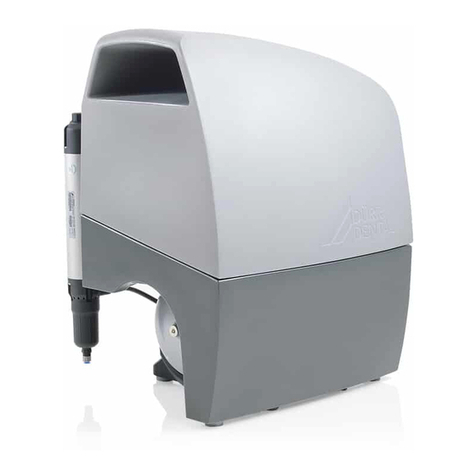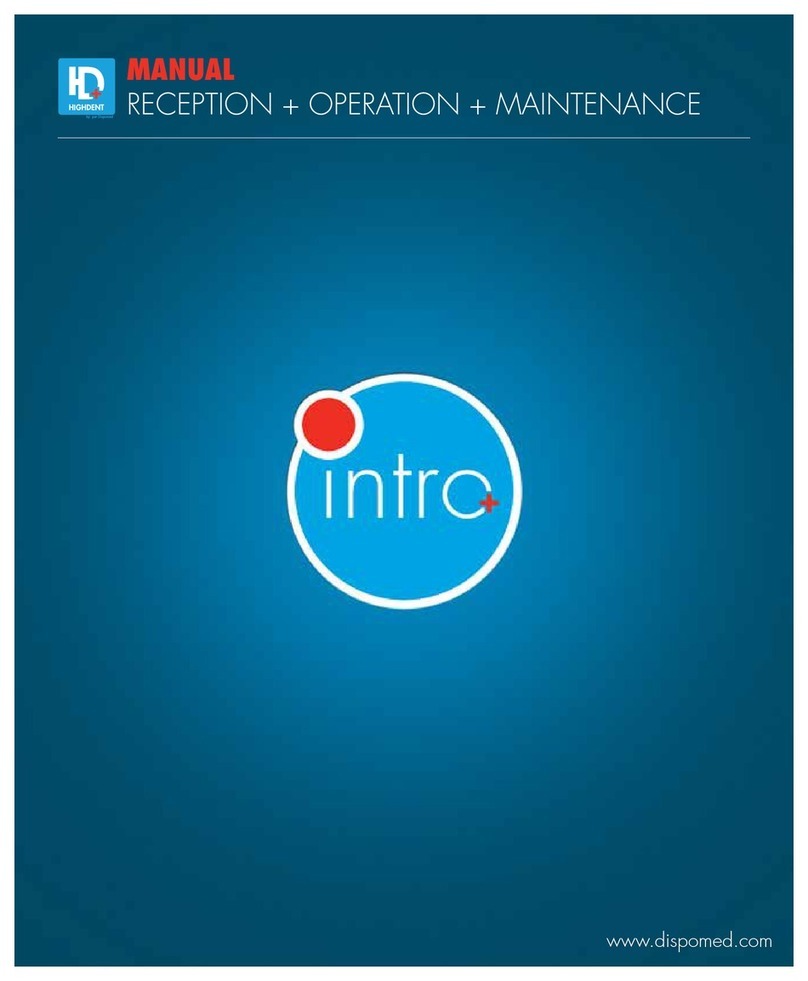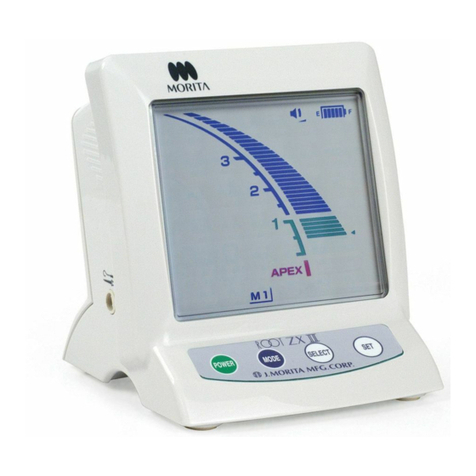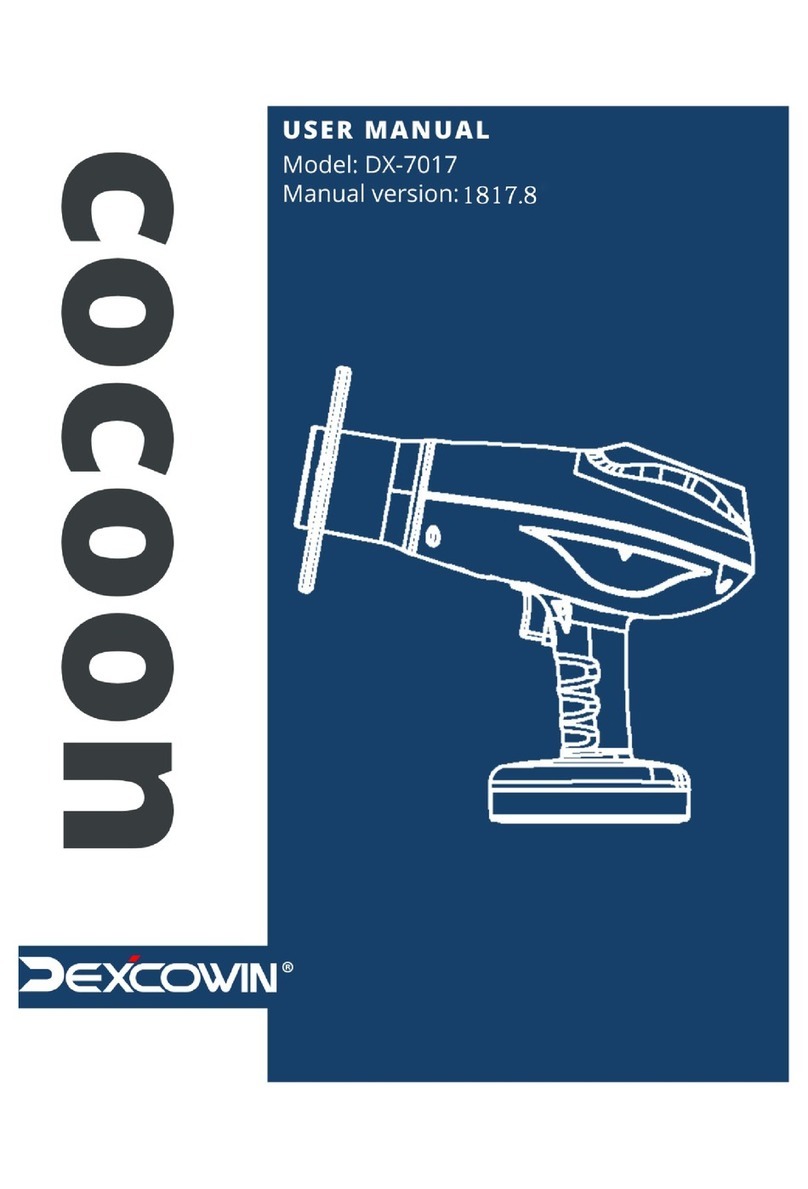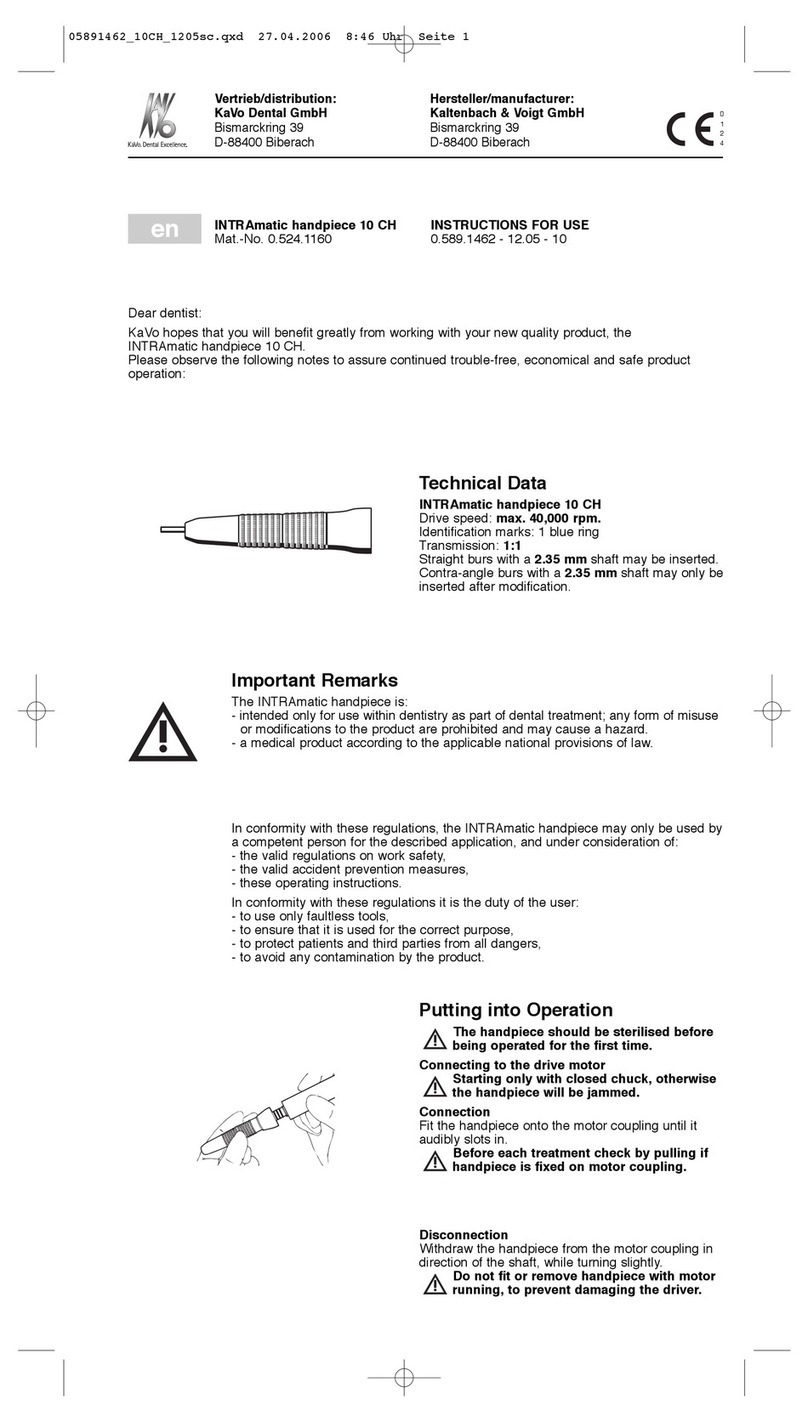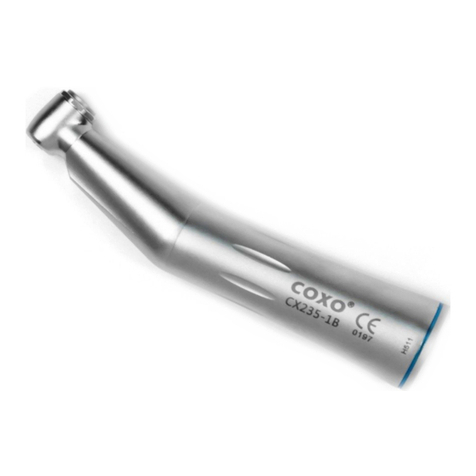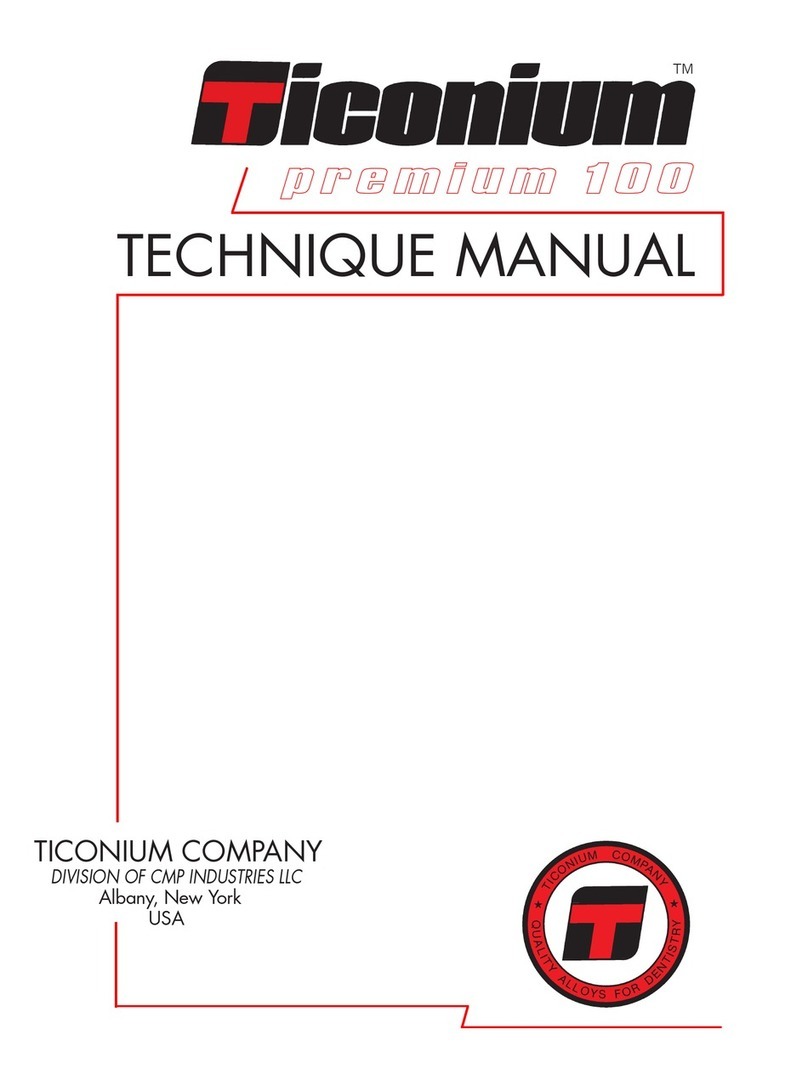3Shape TRIOS 5 Manual

APR 2022
3Shape TRIOS 5
Safety and Setup Guide
L1P-1, L1P-1F

2
ENGLISH
Table of Contents
1. Welcome Note
2. Conformity
3. General Information
3.1 About this Document – Symbols .................................................................................... 2
3.2 Legend of Labels and Symbols........................................................................................ 2
4. Description of TRIOS
4.1 Certification and Compliance Notes .............................................................................. 3
4.2 Intended Use.................................................................................................................. 3
4.3 Users of the TRIOS System ............................................................................................. 3
4.4 Contra-indications......................................................................................................... 3
4.5 Patient Target Group ...................................................................................................... 3
4.6 System Description........................................................................................................ 3
4.7 TRIOS Scanner, TRIOS Scanner Tip and TRIOS Protection Tip Description....................4
4.8 Battery and Battery Charger Description.......................................................................4
4.9 Other System Elements Description..............................................................................4
4.11 Starting and Shutting Down the TRIOS System ............................................................. 5
4.12 Starting TRIOS Online Help........................................................................................... 5
4.13 Storage, Operating and Transport Conditions.............................................................. 5
4.14 Technical Specifications................................................................................................ 5
4.15 Electromagnetic Compability ....................................................................................... 5
4.16 Declaration – Electromagnetic Emissions.................................................................... 6
4.17 Electromagnetic Immunity ...........................................................................................6
4.18 Distances Between System and Other Equipment .......................................................6
5. System Safety
5.1 Prerequisites.................................................................................................................... 7
5.2 Potential Mechanical Damages ...................................................................................... 7
5.3 Explosion Hazards .......................................................................................................... 7
5.4 Electrical Safety ..............................................................................................................8
5.5 Eye Safety........................................................................................................................8
5.6 Hygiene .......................................................................................................................... 8
5.7 Safety when Scanning..................................................................................................... 8
5.8 Epileptic Seizure .............................................................................................................9
5.9 Protection from Overheating ......................................................................................... 9
5.10 EMC Safety .................................................................................................................... 9
6. TRIOS Sleeve ....................................................................................................... 9
7. Cleaning, Disinfection, and Sterilization ............................................................... 9
7.1 TRIOS Scanner Body and Mirror Housing: Cleaning and Disinfection............................. 9
7.2 Pod: Cleaning and Disinfection..................................................................................... 10
7.3 TRIOS Scanner Tip: Cleaning and Sterilization .............................................................. 10
7.4 Cleaning of Batteries, Battery Charger and Other Parts of the System ......................... 11
8. Optical Maintenance
9. Disposal
10. Technical Maintenance
11. Consumable Accessories
12. Vigilance
1. Welcome Note
Dear Customer,
Thank you for purchasing your TRIOS system from 3Shape TRIOS A/S.
The TRIOS system enables you to obtain oral scans of patient’s teeth
for use in dental CAD/CAM systems.
This TRIOS system safety and setup guide describes safety precautions, warnings, and
considerations related to your TRIOS system. For step-by-step instructions regarding
configuration and operation of the TRIOS system, please refer to the online help.
Before assembling or using your TRIOS system, please carefully read and follow
the instructions in this safety and setup guide and in the online help system.
Please always keep this safety and setup guide near the system.
Please follow all safety information and warnings to avoid personal injury,
material damage or damage to your TRIOS system.
Thank you,
3Shape TRIOS A/S
2. Conformity
This guide is published by 3Shape TRIOS A/S, who reserves the right to improve
and modify the contents without prior notice. Modifications will, however, be published
in future editions. All rights reserved.
TRIOS is a trademark of 3Shape TRIOS A/S.
Manufacturer Information
3Shape TRIOS A/S located at Holmens Kanal 7, 1060 Copenhagen, Denmark is legal
manufacturer for devices listed in this guide.
To learn more about 3Shape, our products and global office locations please visit our
website: www.3shape.com
Declaration of Conformity (EU):
3Shape TRIOS A/S hereby declares that the TRIOS observes
the provisions of:
• Medical Device Regulation (EU) 2017/745, (MDR),
• Restriction of Hazardous Substances in Electrical and Electronic Equipment
Directive 2011/65/EU (RoHS),
• Waste electrical and electronic equipment Directive 2012/19/EU (WEEE)
• Registration, Evaluation, Authorization and Restriction of Chemicals Regulation
1907/2006/EC (REACH)
• Radio Equipment Directive (RED) 2014/53/EU
• 94/62/EEC Packaging and Waste Directive
and is in compliance with the following standards: EN (IEC) 60601-1, EN (IEC) 60601-1-2,
EN (IEC) 60601-1-6, EN (IEC) 62471.
3. General Information
IMPORTANT NOTICE
Be sure to observe all warnings!
Please observe all safety information and warnings to prevent personal
injury, material damage or damage to your TRIOS system. Safety information
and warnings are highlighted in this guide using the words WARNING,
CAUTION or NOTICE.
3.1 About this Document – Symbols
WARNING
Warnings regarding situations where a medium risk of injury
to persons exists if the information is not observed.
CAUTION
Information which can affect system functionality if not observed.
IMPORTANT NOTICE
Important information that is not a warning/caution but must be
strictly observed.
3.2 Legend of Labels and Symbols
Date of manufacture
Manufacturer
General warning
Type BF applied part

3
ENGLISH
WEEE Product disposal
Caution
CE marking applicable for European Union
Lot number
Serial Number
Consult instructions for use
Alternating Current
Protective earth (ground)
Warning – dangerous voltage
Expiry Date
Standby
Refer to instruction manual / booklet. Follow instructions for use
Electrical insulation Class II
Medical Device
Global Trade Item Number
Prescription Only (applicable for United States of America)
Model Number
UKCA (applicable for Great Britain)
Disposal information: Li-ion battery recycling
Device Quantity – indicates the number of pieces in the package
Do not re-use
Country of manufacture – “CC” denotes the country code
Unique Device Identifier
4. Description of TRIOS
4.1 Certification and Compliance Notes
CE marking
This product bears CE marking in accordance with the provisions of Medical Device Regulation
(EU) 2017/745, (MDR); Restriction of Hazardous Substances in Electrical and Electronic
Equipment Directive 2011/65/EU (RoHS 2); Waste electrical and electronic equipment Directive
2012/19/EU (WEEE); Registration, Evaluation, Authorization and Restriction of Chemicals
Regulation 1907/2006/EC (REACH); Radio Equipment Directive (RED) 2014/53/EU and
is in compliance with the following standards: EN (IEC) 60601-1, EN (IEC) 60601-1-2,
EN (IEC) 60601-1-6, EN (IEC) 62471.
CAUTION – EU only
CE mark for connected products
Further products which are connected to this unit must also bear the CE marking.
IMPORTANT NOTICE
To comply with the CE marking of the TRIOS system, the TRIOS scanner
must only be used indoors.
Electrical Safety
This system has been tested to conform with the EN (IEC) 60601-1 Safety Standard for medical
electrical devices with a Patient applied part (the standard title is: Medical electrical
equipment – Part 1: General requirements for basic safety and essential performance),
EN (IEC) 60601-1-2 Electromagnetic compatibility – Requirements and tests, and
EN (IEC) 62471 Photobiological safety of lamps.
The system has also been tested to conform with CAN/CSA-C22.2 No. 60601-1:14 and
AAMI/IEC 60601-1:2005 + AMD 1:2012.
CAUTION
Any person who assembles or modifies a medical electrical equipment or
system complying with the standard EN (IEC) 60601-1 (safety requirements
for medical electrical equipment) by combining it with other equipment is
responsible for conducting appropriate inspection and testing to ensure
continued safe use of the equipment and for ensuring that the requirements
of this regulation are met to their full extent for the safety of the patients,
the operators and the environment.
CAUTION
The product needs special precautions regarding electromagnetic
compatibility (EMC) and needs to be installed and put into service according
to the EMC information.
IMPORTANT NOTICE
The system is to be used in a Professional Healthcare Environment.
4.2 Intended Use
L1P-1: The 3Shape TRIOS system is intended to obtain 3D digital images of the topographical
characteristics of teeth, including bite, gingivae and palate directly from the patient’s mouth
or models of the teeth.
L1P-1F (Indications for use): The L1P-1F intraoral scanner (IOS) System is intended to obtain
3D digital images of the topographical characteristics of teeth, including bite, gingivae and
palate directly from the patient’s mouth or models of the teeth including the visualization
and comparison of the 3D scans of the secondary dentition. The L1P-1F system is also
intended for aid in diagnostics of caries.
CAUTION
Unintended use of the TRIOS system can result in physical injury to patients,
operators and damage the system.
4.3 Users of the TRIOS System
The 3Shape TRIOS system is to be operated by legally qualified healthcare professionals
in dental clinics. Using the TRIOS system for any purpose other than the “intended use”
described above may damage the TRIOS system and harm operators and patients.
Proper use of the TRIOS system includes following the operation and maintenance
instructions, and observing warnings and caution descriptions in this user guide.
4.4 Contra-indications
None.
4.5 Patient Target Group
The are no restrictions in patient population amongst the patient target group
of the TRIOS system.
4.6 System Description
The system is available in these variants:
Regional variation can occur regarding the contents of the systems.
L1P-1 TRIOS scanner, supplied with scanner tips, protection tip, sleeve,
pod (holder), batteries, and battery charger.
L1P-1F TRIOS scanner, supplied with scanner tips, protection tip, sleeve,
pod (holder), batteries, battery charger, TRIOS Patient Monitoring
(TPM) software.

4
ENGLISH
4.7 TRIOS Scanner, TRIOS Scanner Tip and TRIOS
Protection Tip Description
TRIOS system consists of:
TRIOS Scanner (L1-2):
Wireless handheld dental intraoral scanner for
scanning a patient.
Two main areas of the TRIOS scanner are referred
to in this guide: mirror housing and scanner body.
TRIOS Scanner tip (TST-11):
Re-usable TRIOS scanner tip attached to the TRIOS
scanner. A tip is needed for the scanner to be able
to scan.
TRIOS Sleeve (TSL-01):
Single use sleeve to cover the TRIOS scanner.
TRIOS Protection Tip (TST-13):
Protects the optical window of the TRIOS scanner
from damage and dirt when the TRIOS scanner
is not in use. Enables the scanner to run self-test,
when mounted.
Please follow the steps below for attaching and detaching the scanner tip and protection tip:
1. To attach the tip, place the tip over the mirror
housing facing downwards until it clicks.
2. To detach the tip, pull the tip away from
the mirror housing.
The TRIOS scanner has built-in tip detection.
A set of TRIOS scanner tips are delivered with the TRIOS scanner.
The TRIOS scanner tip is the only applied part.
IMPORTANT NOTICE
The TRIOS scanner tips can only be mounted one way
4.8 Battery and Battery Charger Description
A set of batteries for the TRIOS scanner (TB-04):
Batteries for the TRIOS scanner with LED light
to indicate battery status.
Be aware that the batteries must be stored and
operated under correct conditions, see section 4.13.
A battery charger (C2BP):
With two ports to charge TB-04 batteries.
Be aware that the battery charger must be stored
and operated under correct conditions,
see section 4.13.
Power (mains) cable and plug:
The charger has a detachable cable (C8 connector) appropriate for your location, supplied
in the packaging.
4.9 Other System Elements Description
Pod (LP1-2):
Holder for the scanner.
A USB wireless dongle for the PC.
A USB license dongle.
For L1P-1F systems:
TRIOS Patient Monitoring (TPM) Software:
Software for aid in diagnostics of caries.
4.10 Setting up TRIOS
It is recommended that unpacking, assembly and connection of the TRIOS System be performed
by TRIOS authorized technical service personnel.
It is recommended to fully charge batteries for the TRIOS scanner before use.
CAUTION
Let the system adjust to room temperature before use.
WARNING
Examine all parts of the system. Look for physical damage, loose parts
or signs of wear that could interfere with proper use and functionality.
Contact your service provider if there is visible damage or malfunctioning.
Charging batteries:
Before you start:
Place the battery charger on a flat surface horizontally.
Step 1: Attach the power cord to the charger and plug it into mains power.
Step 2: Push the batteries one by one into the charger until they click into place.
When charging, the 5 LEDs on the end of the battery will indicate the status:
Each LED represents 20% of the battery capacity.
Five constant LEDs means that the charging
is complete.
While charging is ongoing each LED will light up one
at a time. The battery status will then be shown, with
each LED representing 20% battery capacity.
If any other charging pattern appears, a charging
error has occurred. In this case, remove the
batteries from the charger and reinsert them.
If charging errors continue, please contact 3Shape
There is an LED under the battery charger. The LED has the following indications:
A green light indicates the battery charger is on
and working
A blue light indicates the power is unstable.
Unplug and reinsert the power for the charger.
If the LED continues to indicate a blue light
please contact support (support@3shape.com).
A white light indicates the battery may have been
inserted incorrectly. Try to insert the battery again.
If the LED continues to indicate a white light,
please contact support (support@3shape.com).
Please follow the steps below for assembling the TRIOS system:
Before you start: Place the pod on a flat and horizontal surface optimally in relation
to the patient chair and your work position. Attach the TRIOS protection tip to the
TRIOS scanner if not already in place.
Step 1: Insert a fully charged battery into the rear
of the TRIOS scanner.
Step 2: Place the TRIOS scanner in the pod.
Step 3: Clean and sterilize a TRIOS scanner tip prior to first time usage.
See section 7 for cleaning and sterilization instructions.

5
ENGLISH
4.11 Starting and Shutting Down the TRIOS System
Please follow the steps below to start TRIOS system for the first time:
Step 1: Turn the PC on.
Start 3Shape software.
Step 2: Log on using a default TRIOS Operator.
Step 3: Configure and use your TRIOS system.
Follow on-screen instructions forconnecting tothewireless TRIOS scanner.
When using theTRIOS system, theuser is guided bymessages shown intheTRIOS software.
The TRIOS scanner has an LED ring which indicates the status of the scanner:
A rotating blue light indicates that the TRIOS scanner
is waiting for the TRIOS software to connect to it.
Three blue blinks indicate that the TRIOS scanner is
searching for a scanner application to connect to.
A constant blue light indicates that the TRIOS
scanner is connected to the system, but no
scanner tip is mounted.
A rotating green light indicates that the TRIOS
scanner is heating the TRIOS scanner tip.
A constant green light indicates that the TRIOS
scanner is ready to scan.
A rotating white light indicates that the TRIOS
scanner is waiting for scan data.
A constant white light indicates that the TRIOS
scanner is scanning. The light intensity decreases
if the TRIOS scanner loses registration.
Solid yellow indicates that the battery is low.
Scanner operation
The scanner has two buttons for operation; the button closests to the tip controls scanning
operation, the button farthest from the tip controls navigation.
Power saving
The TRIOS scanner has integrated power control, and will go into sleep mode when not used,
unless the software is on the Scan page.
4.12 Starting TRIOS Online Help
The TRIOS online help can be started from the TRIOS software by clicking on the Help
button and choosing User Manual.
4.13 Storage, Operating and Transport Conditions
Operating Conditions
Ambient temperature range: +15 – +26 °C (+59 – +78.8 °F)
Relative humidity: 10 – 85 % (non-condensing)
Atmospheric pressure: 800 – 1100 hPa
The TRIOS scanner should be used in an environment maintaining a
consistent room temperature.
Storage Conditions
Ambient temperature range: -10 – +50 °C (+14– +122 °F)
Relative humidity: 10 – 85 % (non-condensing)
Atmospheric pressure: 800 – 1100 hPa
Transport Conditions
Ambient temperature range: -10 – +50 °C (+14– +122 °F)
Relative humidity: 10 – 85 % (Non-condensing)
Atmospheric pressure: 620 – 1200 hPa
4.14 Technical Specifications
Light source
specifications
Donot view directly withoptical instruments, such asspectacle
microscopes. Theproduct complies withEN (IEC) 62471
(Photobiological safety oflamps andlamp systems andUL-standard
US code offederal regulations, 21CF 1040.10 and1040.11.
Sterilization Sterilize by autoclave (see section 7 for autoclave specifications)
Power input C2BP: Battery charger
Power input: 100-240 VAC 0.6 A, 50/60 Hz
Protection class: IP20
Insulation class Class II
L1-2 scanner. Wireless, battery powered
3Shape TB-04 Battery:
3,6 V, 3300 mAh, 12 Wh
Wireless TheTRIOS scanner contains an IEEE 802.11ac module
Wireless
Transmit Power
Maximum 100 mW
Wireless
Frequency Band
2.401-2.483 GHz
5.15-5.725 GHz (the actual frequencies are dependent on local
regulations and the configuration of the product.)
IT Network equipment
Network
characteristics
802.11ac (5GHz)
Capacity for at least 40 Mbps per scanner.
Network
configuration
Bi-directional traffic permitted between TRIOS scanner and PC.
mDNS enabled (required for scanner discovery).
Redirection of traffic must be disabled.
Channel width set to at least VHT40 (40MHz).
Ports used:
• TCP ports (Scanner): 20-21, 80 and 23795
• UDP Ports (Scanner): 58218 and 58220-58230
• UDP Ports (PC and Router): 67 (DHCP), 5353 (mDNS)
Security
specification WPA2-PSK authentication
IMPORTANT NOTICE
If you connect your TRIOS intraoral scanner system to your IT Network
equipment, it is strongly recommended to apply network security
measures and to analyse, evaluate, and control the IT network.
4.15 Electromagnetic Compability
The TRIOS system has been tested according Medical electrical equipment – Part 1-2:
General requirements for basic safety and essential performance– Collateral Standard:
Electromagnetic disturbances– Requirements and tests, EN/(IEC) 60601-1-2 ed. 4.0, 2015.
WARNING
Medical electrical equipment needs special precautions regarding EMC
and needs to be installed and put into service according tothe EMC
information provided in this document.
IMPORTANT NOTICE
Portable and mobile RF communications equipment can affect medical
electrical equipment.

6
ENGLISH
4.16 Declaration – Electromagnetic Emissions
The TRIOS system complies with the requirements EN/(IEC) 60601-1-2 (Edition 4.0)
clause 7 Emissions.
The TRIOS system is intended for use in the electromagnetic environment specified below.
The user or users of the TRIOS system should assure thatit is used insuch anenvironment.
Emission
measurement Conformity Electromagnetic
environment– guidelines
RF emission
CISPR11 Group 1 The TRIOS system uses RF energy only for its
internal functions. Therefore, ItsRF emissions
are very low and are notlikely to cause any
interference innearby electronic equipment.
RF emission
CISPR11 Class B
Harmonic
emission
IEC 61000-3-2
Class A The TRIOS system is intended for use
indental clinical settings, including domestic
establishments and those directly connected
to the public low-voltage power supply
network that supplies buildings used
fordomesticpurposes
Voltage
fluctuation and
flicker
IEC 61000-3-3
Complies
4.17 Electromagnetic Immunity
The TRIOS system complies with the requirements EN/(IEC) 60601-1-2 (ed. 4.0)
clause 8 Immunity. The test levels for immunity to RF electromagnetic fields areselected
according to general test conditions for medical equipment.
The TRIOS system is intended for use in a Professional Healthcare Facility Environment with
the electromagnetic environment specified below. The user of The TRIOS system should
assure that it is used in such an environment.
Immunity test IEC 60601 test
level
Compliance
level
Electromagnetic
environment – guidelines
Electrostatic
discharge ESD
IEC 61000-4-2
Contact +/-
8kV.
Air:
+/-15kV.
Contact
+/-8kV.
Air:
+/-15kV.
Floors should be wood,
concrete or ceramic tile. If floors
are covered with synthetic
materials, the relative humidity
should be at least 30 %.
The TRIOS system is allowed
to have a temporary loss
of function, which requires
operator intervention or
system reset.
Electrical fast
transients/burst
IEC 61000-4-4
+/- 2 kV for
power supply
lines
+/-1 kV for
input/ output
lines
+/- 2 kV for
power supply
lines
+/-1 kV for
input/ output
lines
Mains power quality should be
that of a typical commercial
or hospital environment.
During electrical fast
transient/burst the TRIOS
system is allowed to have a
temporary loss of function,
which requires operator
intervention or system reset.
Surge
IEC 61000-4-5
+/-1 kV Line(s)
to earth:
+/-2 kV. Line
to line.
+/-1 kV Line(s)
to earth:
+/-2 kV. Line
to line.
Mains power quality should be
that of a typical commercial or
hospital environment.
Voltage
dips, short
interruption
and voltage
variations
IEC 61000-4-11
0 % UT for 0.5
cycle (1 phase)
0 % UT
for 1 cycle
70 % UT for
25/30 cycles
(50/60 Hz)
0 % UT for 0.5
cycle (1 phase)
0 % UT for
1 cycle
70 % UT for
25/30 cycles
(50/60 Hz)
During the testing the TRIOS
system is allowed to have a
temporary loss of function
which requires operator
intervention or reset.
Power frequency
(50/60Hz)
Magnet field IEC
61000-4-8
30 A/m. 30 A/m. Power frequency magnetic
fields should be at levels
characteristic of a typical
location in a typical domestic
or hospital environment.
Note: UTis the ac mains voltage prior to application of the test level
Immunity test IEC 60601 test level Compliance level
Conducted RF
IEC 61000-4-6
3 Vrms
150 kHz to 80 MHz.
6 Vrms in ISM bands
between 0,15 MHz and
80 MHz (Note b)
[V1] 3 Vrms
[V2] 6 Vrms (Note b)
Radiated RF
IEC 61000-4-3
3 V/m
80 MHz to 2.7 GHz.
[E1] 3 V/m
80 MHz to 2.7 GHz.
Electromagnetic environment – guidelines
Portable and mobile RF communications equipment should be used no closer to any
part of the TRIOS system, including cables, than the recommended separation distance
calculated from the equation applicable to the frequency of transmitter.
Recommended separation distance
d = 1,2 √P
d = 1,2 √P 80 MHz to 800 MHz
d = 2,3 √P 800 MHz to 2,7 GHz
where Pis the maximum output power rating of the transmitter in watts (W) according
to the transmitter manufacture and dis the recommended separation distance in meter
(m), V1 is the conducted RF compliance level, and E1 is the RF radiated compliance level.
Field strengths from fixed RF transmitters, as determined by an electromagnetic site survey,
(note a, b and c) should be less than the compliance level in each frequency range.
Interference may occur in the vicinity of equipment
marked with the following symbol:
Note 1: At 80 MHz and 800 MHz, the higher frequency range applies.
Note 2: These guidelines may not apply in all situations. Electromagnetic propagation is
affected by absorption and reflection from structures, object and people.
Note a: Field strengths from fixed transmitters, such as base stations for radio (cellular/
cordless) telephones and land mobile radios, amateur radio, AM and FM radio broadcast
and TV broadcast cannot be predicted theoretically with accuracy. To assess the
electromagnetic environment due to fixed RF transmitter, an electromagnetic site survey
should be considered. If abnormal performance of the TRIOS system is observed, additional
measures may be necessary, such as re-orienting or relocating the TRIOS system.
Note b: Over the frequency range 150 kHz to 80 MHz, field strengths should be less than 3 V/m.
Note c: The ISM (industrial, scientific and medical) bands between 0,15 MHz and 80 MHz
are 6,765 MHz to 6,795 MHz; 13,553 MHz to 13,567 MHz; 26,957 MHz to 27,283 MHz; and
40,66 MHz to 40,70 MHz. The amateur radio bands between 0,15 MHz and 80 MHz are
1,8 MHz to 2,0 MHz, 3,5 MHz to 4,0 MHz, 5,3 MHz to 5,4 MHz, 7 MHz to 7,3 MHz, 10,1 MHz
to 10,15 MHz, 14 MHz to 14,2 MHz, 18,07 MHz to 18,17 MHz, 21,0 MHz to 21,4 MHz,
24,89 MHz to 24,99 MHz, 28,0 MHz to 29,7 MHz and 50,0 MHz to 54,0 MHz.
Enclosure port immunity to RF wireless communications equipment
Band (MHz) Service Immunity test level (V/m)
380-390 TETRA 400 27
430-470 GMRS460,
FRS 460 28
704-787 LTE Band 13, 17 9
800-960
GSM 800/900,
TETRA 800,
iDEN 820,
CDMA 850,
LTE Band 5
28
1700-1990
GSM 1800;
CDMA 1900;
GSM 1900;
LTE Band 1,3,4, 25;
UMTS
28
2400-2570
Bluetooth,
WLAN,
802.11 b/g/n,
RFID 2450
LTE Band 7
28
5100-5800 WLAN 802.11 a/n 9
4.18 Distances Between System and Other Equipment
The TRIOS system is intended for use in an electromagnetic environment in which
radiated RF disturbances are controlled. The customer or the user of the TRIOS system
can help prevent electromagnetic interference by maintaining a minimum distance
between portable or mobile RF communications equipment (transmitters) andthe
TRIOS system as recommended below, according to the maximum output power ofthe
communicationequipment.
Rated maximum output
power of transmitter, W
Separation distance according to frequency
of transmitter, m
150 kHz
to80 MHz
d = 1,2 P
80 MHz
to800MHz
d = 1,2 P
800 MHz to2,5
GHz
d = 2,3 P
0,01 0,12 0,12 0,23
0,1 0,38 0,38 0,73
1 1,2 1,2 2,3
10 3,8 3,8 7,3
100 12 12 23

7
ENGLISH
For transmitters rated at a maximum output power not listed above, therecommended
separation distance din metres (m) can be estimated using the equation applicable
to the frequency of the trans-mitter, where Pisthemaximum output power rating
of the transmitter in watts (W) according tothetransmitter manufacturer.
Note 1: At 80 MHz and 800 MHz, the separation distance for the higher frequency
range applies.
Note 2: These guidelines may not apply in all situations. Electromagnetic propagation
is affected by absorption and reflection from structures, objects and people.
Models L1P-1 & L1P-1F
Connection Type Recommended use distances
Scanner – PC Wireless
Distance between TRIOS scanner and wifi dongle/
access point should be between 0.5 and 5m for best
performance.
5. System Safety
5.1 Prerequisites
CAUTION
Read all instructions carefully, including all warnings and caution notices.
You must comply with the warnings in this manual to prevent injury
to persons and damage to equipment. Proper functionality and safety can
only be guaranteed if the safety precautions in this safety guide and on
the TRIOS system are observed.
For L1P-1F:
CAUTION
In fluorescence scanning mode:
• Limit exposure of the oral mucosa.
Preventive inspection before use of the system
WARNING
Please examine the TRIOS system for any mechanical damage on:
• All enclosures.
• All cables.
Safety can only be guaranteed if NO DAMAGE to the TRIOS system is observed.
Modifications of the system
Warning
Do not modify the TRIOS system without authorization of the manufacturer.
Approved software only
CAUTION
Install only approved software – to prevent interference with TRIOS system
performance.
Only connect specified items
Warning
Only connect items that have been specified as part of the TRIOS system
or have been specified as being compatible with the TRIOS system.
Training
WARNING
Before you attempt to use the TRIOS system with patients:
• You must have read and understood all sections of this guide describing
correct operation.
• You must be thoroughly familiar with the safe operation of the TRIOS
system as described in this documentation.
• If the instructions for operating the TRIOS system as described in this
guide are NOT observed and followed, the intended function and its
safety for the user and patient may be impaired.
In case of equipment failure
CAUTION
If at any time the TRIOS system malfunctions, or if you suspect in any way
that the TRIOS system is not working correctly:
• Remove the TRIOS scanner contact to patient immediately.
• Unplug the charger and make sure it cannot be used before it is checked.
• Contact your 3Shape support.
• Do not attempt to open any covers on the TRIOS system.
Wireless Connection
The wireless TRIOS scanner is intended to be used indoors, in a domestic or commercial
electromagnetic environment. The wireless connection is intended to relay image stream
data and control data between the TRIOS scanner and the TRIOS software. The communication
between TRIOS Scanner and TRIOS software is handled by 3Shape communication services.
CAUTION
Other portable and mobile RF communication equipment could interfere
with the wireless TRIOS scanner, even if the other equipment complies with
CISPR emission requirements.
CAUTION
The wireless TRIOS scanner could interfere with other portable and mobile
RF communication equipment.
IMPORTANT NOTICE
It is recommended to keep a line of sight between the wireless TRIOS
scanner and the USB wireless dongle attached to the PC.
5.2 Potential Mechanical Damages
Inspect TRIOS scanner tip before using
WARNING
Damaged tip may cause injuries to the patient.
Inspect TRIOS scanner tips before use to ensure
that there is no damage to the TRIOS scanner
tip surfaces.
Dropped or damaged equipment
WARNING
Performance of the scanner tip is compromised
when dropped. If the TRIOS scanner tip is dropped
on the floor, the tip must be disposed of and not
to be used for scanning. (see this guide’s instructions
on 9. Disposal).
WARNING
The performance of the TRIOS scanner may be
compromised when dropped. If the handheld
scanner is dropped or bumped, it must be
checked immediately before further use.
• Unplug the system and make sure it cannot be
used before it is checked.
• Examine the TRIOS system for any mechanical
damage or malfunction.
• If at any time the TRIOS system malfunctions,
or if you suspect in any way that the TRIOS
system is not working correctly contact your
reseller or 3Shape.
• Do not attempt to open any covers on the
TRIOS system.
WARNING
The performance of the battery may be
compromised when dropped, If a battery is
dropped, It must be examined for any mechanical
damage or malfunction. If a mechanical damage
or malfunction is observed or suspected, the
battery must be disposed of (see this guide’s
instructions on 9. Disposal).
WARNING
The performance of the battery charger
may be compromised when dropped, If the
battery charger is dropped, it must be checked
immediately before further use:
• Unplug the TRIOS system and make sure it cannot
be used before it is checked.
• Battery charger must be examined for any
mechanical damages or malfunction.
• If mechanical damage or malfunction
is observed, please contact support
WARNING
To avoid injuries from falling object, always place the TRIOS system on
a horizontal surface.
5.3 Explosion Hazards
Flammable liquids or gases
WARNING
The TRIOS system is not designed to be used in potentially explosive
environments. Do not use the TRIOS system in close proximity to
flammable liquids or gaseous flammable anaesthetic, or in oxygen-
enriched atmospheres.

8
ENGLISH
5.4 Electrical Safety
Do not access the inside of any part of the system
WARNING
There is a risk of electrical shock if you attempt to access the inside of any
part of the system. Only authorized and qualified service personnel may
access the inside of any part of the system.
Spilled liquids
WARNING
The electrical safety of the system may be compromised if it is exposed to
any liquids. Do not bring liquids, such as beverages, near the TRIOS system.
Do not spill liquids, such as cleaning agent, on the TRIOS system.
Do not use a power strip
WARNING
Failure to establish a ground connection may compromise electrical safety. Do
not connect the Battery Charger to an ordinary power strip or extension cord.
Stress on cables
CAUTION
External cables must never be subjected to pulling stress.
Condensation
CAUTION
Variations in temperature or humidity may cause water to condense inside
the system, which can cause damage. Always let the system reach room
temperature before you plug it into the power source.
If the system has been subject to major temperature or humidity changes,
wait until the system has reached room temperature before plugging it
into the power source.
If there is visible evidence of condensation, wait at least 8 hours
before plugging it into the power source, to ensure that no internal
condensation occurs.
Please see operating conditions for further information.
Disconnect the battery charger before cleaning
WARNING
The electrical safety of the system may be compromised if it is exposed
to excessive amounts of cleaning liquids. Disconnect the battery charger
from power before cleaning and allow to dry before reconnecting.
Disconnecting from mains
IMPORTANT NOTICE
There is no power ON/OFF switch on the system; therefore, the only reliable
means to disconnect the system from mains is to unplug the charger power
cord. Do not position the system so that it is difficult to unplug the charger
power cord.
PC connection options and requirements
CAUTION
The PC should be located at least 1.5 m away from the patient. Do not scan
the patient and touch the PC at the same time! You must not touch any
peripherals connected with a cable to the PC while scanning a patient.
See the PC’s instructions for use for further details.
5.5 Eye Safety
CAUTION
The TRIOS scanner emits bright light from its TRIOS scanner tip during
operation. The TRIOS scanner complies with EN (IEC) 62471 (Photobiological
safety of lamps and lamp systems). However, we recommend caution when
handling the TRIOS scanner.
A brief glimpse of the light into the eye is not dangerous, but do not stare
into the beam or view directly with optical instruments, and do not aim the
beam towards other people’s eyes. In general, viewing bright light sources
(e.g. headlights), which have a high secondary exposure potential due
to their blinding effect, may cause temporary reduction in visual acuity
and afterimages, leading to irritation, annoyance, visual impairment,
and even accidents, depending on the situation.
5.6 Hygiene
For instructions on how to mount the single-use sleeve see the TRIOS Sleeve instructions for use.
For instructions on cleaning and disinfection or sterilization go to section 7.
Always wear gloves
WARNING
To maintain a clean work environment and the
safety of the patient, wear clean examination
gloves when:
• Handling the TRIOS scanner tip – changing
the tip or handling the window.
• Handling the TRIOS protection tip.
• Applying the TRIOS scanner for scanning
patients.
• Touching the TRIOS system.
Prepare the TRIOS scanner
WARNING
In order to avoid cross contamination between patients before each use
you must:
• apply a newly sterilized TRIOS scanner tip to the TRIOS scanner.
• apply a new TRIOS scanner sleeve to cover the TRIOS scanner.
See the detailed instruction in the TRIOS Sleeve Instructions for use.
Reprocess system after each patient
WARNING
In order to avoid cross contamination between
patients you must before each use:
• clean and disinfect or sterilize relevant parts
of the TRIOS system.
• clean and disinfect the TRIOS scanner before
attaching the TRIOS protection tip. Do not allow
patient contact with the TRIOS protection tip.
• dispose the TRIOS scanner sleeve
Clean and disinfect TRIOS scanner before mounting TRIOS protection tip
WARNING
Always clean and disinfect the TRIOS scanner before attaching the TRIOS
protection tip. Do not allow patient contact with the TRIOS protection tip.
Scan only with TRIOS scanner tip on
WARNING
In order to avoid cross contamination between patients and maximal
electrical safety the scanner tip must be mounted when the scanner is
inserted into the patient’s mouth or when the scanner comes in contact
with the patient in any way. Mounting of the scanner tip is required
for the intended function of the scanner.
IMPORTANT NOTICE
Before each patient, make sure any PC connected to the system and its
peripherals are disinfected. It is recommended to use medical-grade
peripherals (e.g., keyboards and mice) that can be cleaned and
disinfected easily.
5.7 Safety when Scanning
CAUTION
The TRIOS scanner is a highly precise optical instrument and must
be handled carefully. Do not drop, shake or bump the TRIOS scanner,
as these actions could cause it to break or malfunction.
Follow these guidelines:
• Always return the TRIOS scanner to its mount when not in use.
• Do not submerge the TRIOS scanner in any liquids.
• Do not place the TRIOS scanner on heated or wet surfaces.
• Grip the TRIOS scanner firmly during scanning and when removing/
returning it to its mount.
IMPORTANT NOTICE
The TRIOS scanner will get warm during use. This is normal but not part
of any patient treatment.
CAUTION
The TRIOS scanner tip is fragile and contains a delicate window.
To avoid damage to the tip and window, take care not to bump the tip
onto the patient’s teeth or restorations.
CAUTION
When the TRIOS system is used for pediatric patients, please pay extra
attention while scanning the patient.

9
ENGLISH
5.8 Epileptic Seizure
WARNING
There is a risk of injuries if the scanner tip is bitten. As a direct effect of an
epileptic seizure, various degrees of involuntary biting can occur. Avoid any
patient biting on the scanner tip or bumping the scanner tip into the teeth.
5.9 Protection from Overheating
WARNING
The scanner may become uncomfortably warm and eventually shut down
if the ventilation is obstructed.
The ventilation openings in the rear of the handheld scanner must never
be blocked or obstructed.
5.10 EMC Safety
WARNING
Use of accessories, transducers, and cables other than those specified or
provided by the manufacturer of this equipment could result in increased
electromagnetic emissions or decreased electromagnetic immunity of this
equipment and result in improper operation.
WARNING
Use of the TRIOS system adjacent to or stacked with other equipment
should be avoided because it could result in improper operation. If such
use is necessary, the TRIOS system and the other equipment should be
observed to ensure normal operation in the used configuration.
Portable RF communications equipment
WARNING
Portable RF communications equipment (including peripherals such as
antenna cables and external antennas) should be used no closer than 30
cm (12 inches) to any part of the TRIOS system, including cables specified
by the manufacturer. Otherwise degradation of the performance of system
may occur.
6. TRIOS Sleeve
The TRIOS Sleeve is a protective barrier to minimize the risk of microbial cross-contamination.
For mounting, please see the TRIOS Sleeve instructions for use.
CAUTION
It is recommended to use the TRIOS Sleeve to cover the TRIOS scanner
during patient examination.
WARNING
The TRIOS Sleeve must only be used once to avoid cross-contamination.
7. Cleaning, Disinfection, and Sterilization
Thefollowing TRIOS system items shall be cleaned and disinfected or sterilized.
Instructions are described in the following sections: 7.1, 7.2 and 7.3.
TRIOS scanner body and mirror housing
Cleaning and disinfection.
See section 7.1
Pod
Cleaning and disinfection.
See section 7.2
TRIOS scanner tip
Cleaning and sterilization.
See section 7.3
Accessories and materials: Cleaning and disinfection
Thefollowing Accessories and materials are recommended to use
for cleaning and disinfection.
Examination gloves
Cleaning/disinfectant wipes containing Isopropanol (17.2%)
and Ammonium Chloride
e.g. CaviWipes.
Soft bristled brush
E.g. Curaprox ultra soft toothbrush.
A non-enzymatic pH neutral detergent
E.g. Intercept.
Non-woven swab
E.g. Abena non-woven swabs.
FDA-clearedsterilizationpouch
7.1 TRIOS Scanner Body and Mirror Housing:
Cleaning and Disinfection
Clean and disinfect the TRIOS scanner body and mirror housing after each patient treatment
(step 1-4). Also note that the scanner window is a delicate optical component and should be
handled with extra care during cleaning and disinfection (see below).
Step 1: Remove gross contaminants
Wearing gloves, remove TRIOS Sleeve and TRIOS
scanner tip from TRIOS scanner body.
Take a CaviWipe.
Wipe the surface of the TRIOS scanner body
and mirror housing with a CaviWipe to remove
any gross contaminants.
Dispose of the CaviWipe.
Step 2: Clean with brush
While still wet from the CaviWipe, use a dry soft
bristled brush to clean around the gasket area
(where the TRIOS scanner body and mirror
housing connect).
Use the brush to clean around the silicone
button area.
Step 3: Wipe clean
Take another CaviWipe.
Wipe the surface of the TRIOS scanner body
and mirror housing with a CaviWipe.

10
ENGLISH
Dispose of the CaviWipe.
Step 4: Disinfect
Take a CaviWipe.
Wet the surface of the TRIOS scanner body and
mirror housing with the CaviWipe for a minimum
of 120 seconds to disinfect.
Allow to dry.
Dispose of the CaviWipe.
Place TRIOS protection tip on TRIOS scanner.
CAUTION
The TRIOS scanner’s window is a delicate optical component. Its clean and
undamaged surface is critical for the scan quality. The window should be
handled with care. Make sure it is free from lint, stains, and other kinds of dirt.
CAUTION
Never submerge the TRIOS scanner into any cleaning or disinfection solution.
CAUTION
Before returning the TRIOS scanner to its holder, ensure both are dry.
IMPORTANT NOTICE
The TRIOS scanner shell might get yellow-toned over a long period of use.
7.2 Pod: Cleaning and Disinfection
It is recommended to disassemble the pod in order to thoroughly clean it.
Follow the instructions below (step 1-6)
Step 1: Disassemble pod
Wearing gloves, remove the rubber insert from
the pod (holder) by pressing down on the middle
using a thumb and gripping the outer edge with
the index finger.
Step 2: Remove gross contaminants from rubber insert
Take a CaviWipe.
Wipe the surface of the top rubber insert to remove
any gross contaminants.
Dispose of the CaviWipe.
Step 3: Remove gross contaminants from metal holder
Take a CaviWipe.
Wipe the surface of the metal holder to remove any
gross contaminants.
Dispose of the CaviWipe.
Step 4: Disinfect rubber insert
Take another CaviWipe.
Wet the surface of the rubber insert for minimum
120 seconds to disinfect.
Dispose of the CaviWipe.
Step 5: Disinfect metal holder
Take a CaviWipe.
Wet the surface of the metal part for minimum
120 seconds to disinfect.
Dispose of the CaviWipe.
Step 6: Assemble pod
Allow both parts to dry. Assemble the pod (holder).
7.3 TRIOS Scanner Tip: Cleaning and Sterilization
TheTRIOS scanner tip isthepart of theTRIOS scanner that isinserted intothepatient’s
mouth during scanning. TheTRIOS scanner tip canbe re-used up to 60times. The TRIOS
scanner tip should be cleaned and sterilized prior to its first use on patients and after each
use on a patient toavoid cross-contamination.
Step 1: Clean TRIOS scanner tip
Wearing gloves, cleantheTRIOS scanner tip
manually using detergent diluted according
to manufacturer’s instructions.
Apply the detergent directly on a soft bristled brush.
Wash the TRIOS scanner tip under running lukewarm
(30-40 °C) utility water.
Inspect thewindowof theTRIOS scanner tip
after cleaning. Ifthewindowappears withstains,
smudged orwithamilky haze, repeat this step.
Step 2: Rinse and dry TRIOS scanner tip
Rinsewithlukewarm (30-40 °C) tap water.

11
ENGLISH
Dry theTRIOS scanner tipcarefully withanon-
woven swab.
Step 3: Sterilize TRIOS scanner tip
Put theTRIOS scanner tip ina sterilizationpouch.
Thepouch should be sealed. Use either aself-
adhesive orheat-sealed pouch.
Sterilize thepouched TRIOS scanner tip
inaDynamic-Air-Removal Steam Sterilizer
(Class B autoclave) withone ofthetwoprograms
depending on your region:
In the US: Autoclave the TRIOS scanner tip at 132 °C
(269.6 °F) with acycle of 4 minutes exposure time
and 30 minutes dry time.
In the EU: Autoclave the TRIOS scanner tip at 134 °C
(273.2 °F) with acycle of 3 minutes exposure time
and 30 minutes dry time.
CAUTION
Thewindow intheTRIOS scanner tip isadelicate optical component.
Itscleanandundamaged surface iscritical forthescanquality.
Thewindowshould be handled withcare. Donot scratch it.
Becareful not tosmudge it before scanning apatient.
CAUTION
Always cleantheTRIOS scanner tip immediately after use.
Ifbiological materials (bioburden) are allowed todry onequipment,
disinfectionandsterilizationprocesses may not beeffective.
CAUTION
Never autoclave aTRIOS scanner tip that isnot wrapped, since thiswill
leave unremovable stains onthemirror. Seetheautoclave manual
formore information.
CAUTION
New TRIOS scanner tips must be cleaned andsterilized before using
them forthefirst time.
CAUTION
A class B Vacuum autoclave according to EN 13060 is required
for sterilization of the TRIOS scanner tip.
CAUTION
The TRIOS scanner tip can be re-sterilized up to 60 times and must
be disposed afterwards as described in section 9 Disposal.
7.4 Cleaning of Batteries, Battery Charger and Other
Parts of the System
For cleaning of batteries, battery charger, and other parts of the system, please follow
the instructions below:
Cleaning of battery:
Apply a mild detergent to a soft, damp cloth
and wipe the surface of the battery.
Cleaning of battery charger:
Apply a mild detergent to a soft, damp cloth
and wipe the surface of the battery charger.
For general cleaning, apply a mild detergent to a soft, damp cloth.
CAUTION
Do not spray directly onto any parts of the system, as the liquid solution
can accumulate at the seals and leak into the TRIOS scanner, cords or pod.
8. Optical Maintenance
In case of smudges or stains on the TRIOS scanner tip window or the TRIOS scanner window,
follow these steps for optimal scan quality:
Step 1: Take a damp non-woven swab and gently rub it on the inside and outside
of the TRIOS scanner tip window as well as on the window on the mirror housing.
Step 2: Use a dry non-woven swab to dry the windows.
CAUTION
Do not use acetone, IPA, alcohol, or any oxidizing solutions to clean
the TRIOS scanner tip window or the TRIOS scanner window.
9. Disposal
Electronic waste must not be treated as unsorted municipal waste, but
who can inform you about the local requirements for disposal of electronical,
clinical waste. By disposing of the device in the proper manner, you help to avoid
possible hazards for the environment and public health that could otherwise be
caused by improper treatment of waste equipment.
Disposal of the TRIOS scanner tip and TRIOS Sleeve
Please dispose according to standard operating procedures or local regulations for disposal
of contaminated medical waste.
CAUTION
Dispose the TRIOS scanner tip and TRIOS Sleeve as clinical waste.
Disposal of the TRIOS System and packaging
Please dispose according to standard operating procedure or local regulations for disposal
of general waste and electronic waste.
CAUTION
Batteries need to be removed and recycled or disposed of properly.
TRIOS scanner batteries need to be disposed of as lithium-ion batteries.
Lithium-ion batteries are recyclable and must not be treated as unsorted
municipal waste, but must be collected separately.
10. Technical Maintenance
CAUTION
All technical service and repair of the TRIOS system must be performed
by 3Shape or 3Shape-authorized personnel only.
No regular maintenance is needed other other than cleaning, disinfection and sterilization,
as described here. Preventive and scheduled maintenance are not required.
11. Consumable Accessories
The consumable accessories to the TRIOS system are the scanner tips, batteries and
TRIOS sleeves. New consumable accessories can be re-ordered by contacting 3Shape.
Replacements
TRIOS Tip Tips 3-pack TST-11-3
TRIOS Sleeve TRIOS Sleeve TSL-01
TRIOS Battery Battery 3-pack TB-04-3
12. Vigilance
In case of any serious incident that has occurred in relation to the use of the device, please
to the competent authority of the state in which the user and/or patient is established.

10030138A April 2022 Copyright 3Shape TRIOS A/S
More information at 3Shape.com
Let’s change dentistry together
3Shape TRIOS A/S
Holmens Kanal 7
1060 Copenhagen
Denmark
This manual suits for next models
2
Table of contents
Other 3Shape Dental Equipment manuals
Popular Dental Equipment manuals by other brands

Morita
Morita Signo T500 Operation instructions
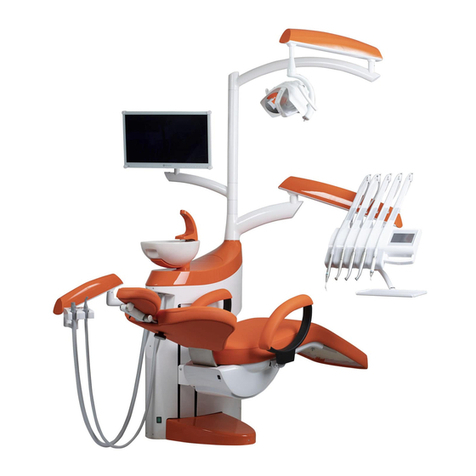
Chirana Medical
Chirana Medical CHEESE L Instructions for use
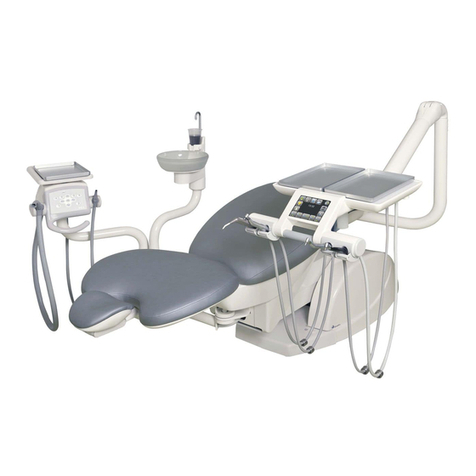
Airel Quetin
Airel Quetin PE8 Manual for use

Renfert
Renfert Twister evolution pro instruction manual
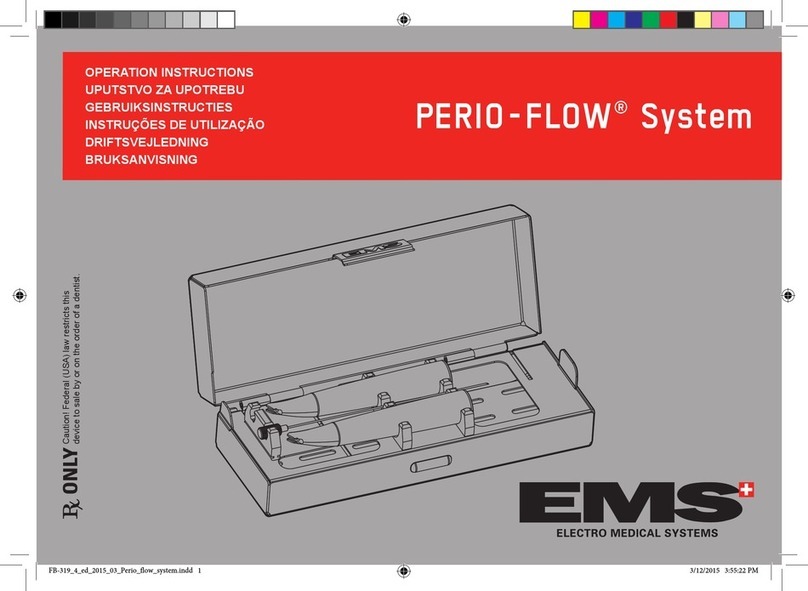
EMS
EMS PERIOFLOW EL-354 Operation instructions

Durr Dental
Durr Dental Tornado 4 Installation and operating instructions

